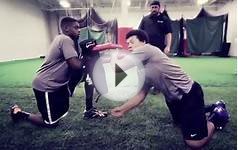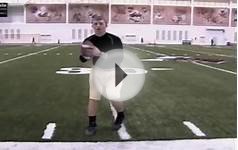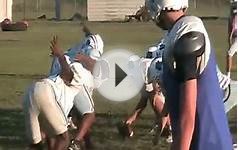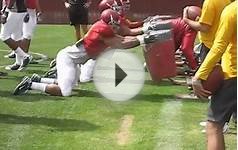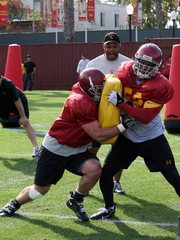
- The defensive lineman makes contact with the opponent every time he is on the field. His physically demanding position requires tremendous focus, as he is always in the middle of the action
- Defensive line drills can incorporate tackling drills and agility drills
Taking a Stance and Moving on the Ball
Taking the proper stance allows a defensive lineman to maximize his effectiveness. Taking a stance begins with the player standing with his feet pointing straight ahead and at shoulder width. Keeping his back straight and his head up, the lineman bends his knees until he is able to rest his forearms on the insides of his thighs. Then the defensive lineman puts his hands on the ground, just a bit ahead of his shoulders. The palms should be off the ground so that the player is leaning down on his fingers. If it is a passing down, the lineman may take a staggered stance. The foot that is closest to the ball is moved back so that the toes are even with the heel of the other foot. A good defensive line drill is to have the lineman practice getting into this stance and exploding forward when a coach in the center position moves the ball or moves his body.
How a defensive lineman moves on the ball depends on whether the defensive formation assigns him to control his position or penetrate an offensive gap. If he is controlling his position, his first step is a quick side step in the direction of his primary area of responsibility. If he is penetrating, his first step is a crossover step in the direction of the gap. The lineman should stay low while making his first step regardless of his assignment.
Defeating Blocks
Defeating blocks is the key to success for a defensive lineman. He will encounter many types of blocks: drive, hook, angle, scoop, double team, trap, and lead. To defeat the drive block, the defensive lineman must have forward momentum and hit the offensive lineman below the shoulder pads. Then the defensive lineman points his helmet toward his assigned position and pushes the offensive lineman away by placing his hands on his opponent’s chest. In a hook block, the offensive lineman tries to drive his shoulder into the defensive lineman’s belly. The defensive lineman needs to get his arms extended so he can get his hands on his opponent’s shoulder pads and push him away. In an angle block, the defensive lineman is blocked by an offensive lineman who is not directly in front of him. The defensive lineman needs to take a short step toward this blocker, lean into him with a shoulder pad and strike at his chest with a forearm.


